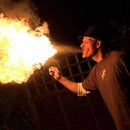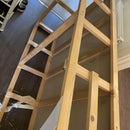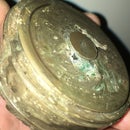Introduction: Making Iron Oxide a Different Way (& Supplement)
Iron is also used in it's oxide form in old Audio & Video cassette tapes.
Iron is within the centre of our Planet, in Meteors, Our Sun and our bodies blood for carrying oxygen.....
The point of my instructable is to be a practical and educational guide to making a usable small scale product. I will be demonstrating a very unique way of producing this very useful chemical.
Step 1: Gathering Materials
Step 2: Necessary Tools
Leathers and Cottons only --//cotton overalls - welder a gloves - googles
Tongs / Pliers / Hammer/ Steel Block /Lump Hammer / 10+ Ton Press /Fine Sieve / Map Gas Torch/ Air-Line /75mm X100mmX 3mm Steel Pipe-Or Empty Co2 Mig Bottle Cut at Both Ends.....Fire brick or Breeze Block. Small steel plate to slightly cover cylinder. Ventilation.
Step 3: Your Set Up
Step 4: The Process Involved
William Kelly (inventor) - Wikipedia, the free encyclopedia
https://en.m.wikipedia.org › wiki › Willia...
Step 5: The Chemistry
Step 6: Air Boiling Continued.
Step 7: Finishing & Processing Iron Oxide
As we approach the end of this journey we now have to process our product, which at the moment is approximately 65% iron oxide and 35% inclusion of solid Steel fragments (precipitated higher alloys and unchanged Starting materials. Now all we have to do is perform several refining steps, involving a PRESS - SIEVE - each time removing large metal fragments not converted. Repeating several times until we have a very reasonable fine powder consisting of FeO-FeO2/O3 with some slight impurities .... What we end up with is a product which can be used by the Back-Yard scientist Or home experimentalist.
>>>>>Science Supplient<<<<<< :- If the steel weighed before conversion, then weighed after the oxidation process the difference in weights will be the total amount of Oxygen that has bonded to our original starting material. Divide this by 16.0 and this is how many Moles of [O] you have or by 32.0 for moles of [O2] gas that has bonded.
Next to work out overall Yield, The solid products, (lumps of higher alloys, large Metal pieces and original starting materials left after Pressing & Sieving Several times until no more powder forms, is still unconverted metal ........By weighing and subtracting this, from the original weight you started with before the process was carried out and we end up with a percentage of conversion Example [Before Conversion, I had 545gms After Conversion, the solid Weight was 645gms which is a difference of 100gms 100/16 = 6.25Mols of Oxygen or 3.125M or Oxygen Gas as this is a diatomic molecule.
--- many thanks for watching please enjoy and comment ;-D
Step 8: Alternative to a Press
When I wrote and published this instructable I soon realised that If anyone wanted to reproduce my instructions, that they may have problems with the final stage of refining /extracting a usable product without the aid of a press. I have since thought long and hard and recently revised this process. One available alternative is a Ball Mill - if the chunk we start with is broken into simpler chunks, then added to a Ball-Mill I would expect after some time we could end up with a fine powder. However I have not tried this as I have no mill and can't be fussed with making one specially for this one use.
I have another tried and tested method which is not by any means quick but it certainly does the job All we need is:
1) An area of Hard Standing such as a concrete floor. 2) A chunk of Pallet wood, the spacer piece 5" square or there about's. 3) 2 Lump Hammers. 4) A Thick walled Metal Tube (Truck Gudgeon Pin). and 5) A Pin or 1/2" Drive extension which fits inside the G/pin).
Method: View Pictures Above:-
1) First Lay block on Hard Standing/Floor.
2) then place Lump Hammer on its side, on top of the wood.
3) Take Gudgeon Pin or Thick Walled Metal tube, vertically place on hammer face.
4) Then Fill tube half way with chunks of our product.
5) using internal Rod or 1/2" drive extension, place inside tube.
6) Using other lump hammer Hit very hard with a determined, vertical blow/ impact. Making sure to hold everything steady, and rotating the pin 90o on each impact. Next we turn the hollow pin or tube upside down and repeat, each time you will be left with a pile of powder underneath, make sure you collect this each time you invert the tube after every few impacts.
A methodology and keen eye is necessary for Removing large metal pieces and sorting through to determine if more steps are needed. As paying close attention to grain size helps with the refining process and the quality of the finished product.
This method may seem long winded, but its a tribute to patience and versatility, eventually you will have fruits from your labour.......





